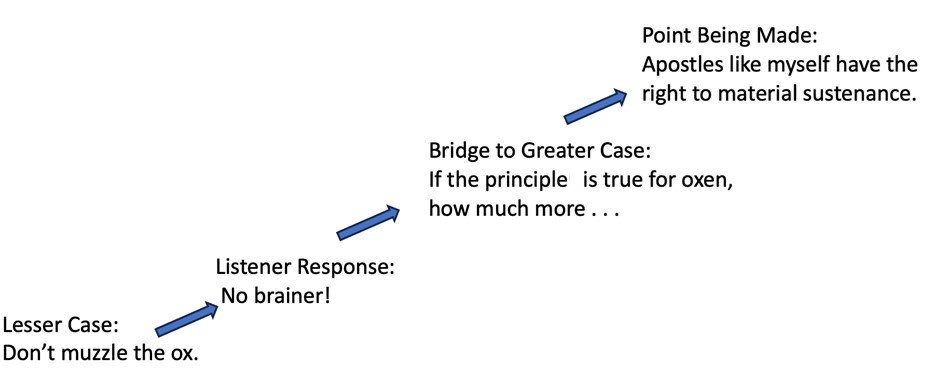Skill Builders
Article
Persuading Like Jesus

As the West continues to slide into a post-Christian worldview and lifestyle, preachers will do well to sharpen their skills in persuasion. To do this, we can learn from our Lord and use the greater-to-lesser (and lesser-to-greater) argument.
To do this, a speaker begins by stating something that the listeners already believes—a “no-brainer”—and then connects that belief to a second statement that is not so obvious, the point actually in the crosshairs of argumentation. Such reasoning is so common that you may not notice it when it flashes by in conversation:
[greater-to-lesser] The rope is strong enough to hold me (and I weigh 235 pounds!); surely it will hold you (you weigh only 135 pounds).
[lesser-to-greater] If it is wrong to use a quotation in a sermon without giving credit, then surely it is wrong to plagiarize an entire sermon without giving credit.
Arguementum a Fortiori
The Apostle Paul used this in 1 Corinthians 9. Moving from a lesser case in the Law, where God commanded that oxen should be allowed to eat grain as they tread it out, he bridged to the greater case, the point he was arguing: for his work as an apostle, Paul had the right to receive material sustenance from the Corinthians (although he did not make use of that right).

The technical term for this kind of logic is argumentum a fortiori, meaning “argument from the stronger reason.” (“Stronger” refers to the affirmation the audience gives the first assertion, the no-brainer statement). In Jewish Talmudic law it is called kal va-chomer, meaning “mild and severe.” This persuasive strategy is the “yes . . . and” technique. The listeners say “yes” to the first proposition, and then they affirm the second. Greater-to-lesser enrolls listeners in their own persuasion as they connect the dots the speaker draws.
The Lord did this often. He would begin with a non-controversial issue, a no-brainer, and then extend the logic to the point he wished to make. Scanning through the Book of Matthew, I see these examples:
- [lesser-to-greater] To challenge the disciples to take radical steps to safeguard themselves from temptation, he exhorted: if your eye causes you to sin, tear it out (how’s that for a “lesser” case?): “For it is better that you lose one of your members than that your whole body be thrown into hell.” (5:29-30)
- [lesser-to-greater] To convince his disciples to pray, he reasoned: earthly fathers know how to give good gifts like bread and fish; how much more will your heavenly Father give good things to those who ask him? (7:9-10)
- [lesser-to-greater] To convince unbelieving scribes that he had power to forgive sins (the more difficult thing), he healed the paralytic (a comparatively easy thing): “That you may know that the Son of Man has authority on earth to forgive sins,”—he said to the paralytic—“Rise, pick up your bed and go home.” (9:1-7)
- [greater-to-lesser] To prepare his disciples for persecution: “If they have called the master of the house Beelzebul, how much more will they malign those of his household.” (10:24-25)
- [lesser-to-greater] Again, to prepare the disciples to remain faithful when persecuted: “Do not fear those who kill the body but cannot kill the soul. Rather fear him who can destroy both soul and body in hell.” (10:28)
- [lesser-to-greater] Yet again, to move the disciples to not fear the coming persecution: “Are not two sparrows sold for a penny? And not one of them will fall to the ground apart from your Father…. Fear not, therefore, you are of more value than many sparrows.” (10:29-31)
- [lesser-to-greater] To defend his working on the Sabbath (healing a man with a withered hand): “Which one of you who has a sheep, if it falls into a pit on the Sabbath, will not take hold of it and lift it out? Of how much more value is a man than a sheep! So it is lawful to do good on the Sabbath.” (12:11-12)
- [greater-to-lesser] In a surprising twist, the Canaanite woman used argumentum a fortiori on Jesus. At first, Jesus refused to heal her because his ministry was to the Jewish people. He put it this way: “It is not right to take the children’s bread and throw it to the dogs.” In other words, healing is for the Jews, not Gentiles. The woman affirmed this, but also extended the truth to her own “lesser case.” She said, “Yes, Lord, yet even the dogs eat the crumbs that fall from their masters’ table.” (15:26-28)
- [greater-to-lesser] To move his disciples to forgive those who wrong them, Jesus used a greater-to-lesser- parable: The master forgave his servant 10,000 talents; and the scoundrel turned around and choked a fellow servant because he owed him 100 denarii. Jesus’s point? “You wicked servant! I forgave you all that debt because you pleaded with me. And should not you have had mercy on your fellow servant, as I had mercy on you?” (18:23-35)
- [lesser-to-greater] To excoriate the Pharisees for their convoluted, misguided, and silly rules about taking oaths, Jesus showed the flaw in their reasoning: “You blind men! For which is greater, the gift or the altar that makes the gift sacred? So whoever swears by the altar swears by it and everything on it. And whoever swears by the temple swears by it and by him who dwells in it.” (23:19-21)
How to Apply this Technique
In our own preaching, lesser-to-greater might sound like this:
- We have laws that protect animals, including unborn animals. For example, you can be fined heavily for destroying the egg of a bald eagle. That’s a good law. How much more should we protect an unborn baby still in the mother’s womb.
- To heal, the doctor sometimes has to hurt. For example, the doctor may order a vaccination. As a result, your arm might ache for a day and you may have a low-grade fever, but the vaccination also gives you something greater than the inconvenience—immunity. No smallpox, no polio. In the same way, our Great Physician may allow trials to buffet and bruise us. But the goal is spiritual health: Christlike attitudes and actions. That’s how Paul reasoned in 2 Corinthians: to keep me from becoming conceited, God allowed a thorn in the flesh.
- The more we discover about the natural world, the more we realize that our knowledge has only scratched the surface of the vast, complex, beautiful, and mind-boggling universe: black holes and dark matter; quarks and leptons; a curved universe and multiple dimensions. If we shake our heads in wonder at the natural world, how much more should we stand in awe of the Creator who formed all that is.
- We celebrate New Year’s Eve with fireworks and parties. What fun! How much more should we also celebrate the coming of the Lord Jesus to earth. He came not with a vague hope that the new year will be better than the previous year, but in the certain assurance that he will renew all of creation. “Joy to the world! The Lord has come!”
- If you saw a wild animal prowling your neighbor’s backyard, you would warn them, wouldn’t you? Of course you would! If you saw a child wandering mindlessly toward a busy road, you would swoop in to protect that child, wouldn’t you? Of course you would! Should we not also warn our neighbors of the coming judgment? Should we not also protect our children by caring for their souls, teaching them to love God with heart, soul, mind, and strength?
Take a page from our Rabbi’s teaching ministry by starting with something the audience already affirms, then show how that case applies to the point at hand. Greater-to-lesser or lesser-to-greater is a terrific way to stand between the worlds of the text and the listeners.
Jeffrey Arthur is professor of preaching and communication at Gordon-Conwell Theological Seminary.










